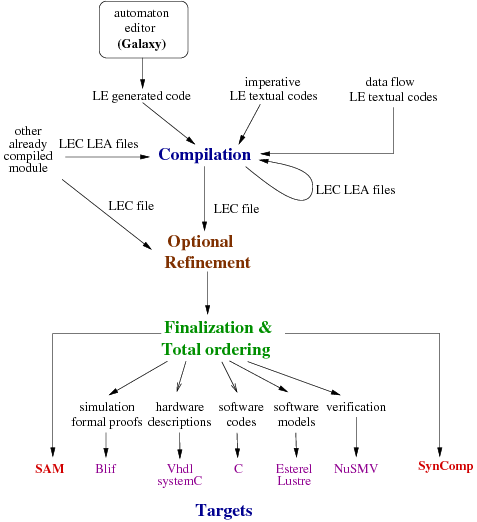Section: New Results
The Clem Workflow
Participants : Annie Ressouche, Daniel Gaffé, Mohamed Bouatira, Ines Sarray.
Keywords: Synchronous languages, Synchronous Modelling, Model checking, Mealy machine.
This research axis concerns the theoretical study of a synchronous language le with modular compilation and the development of a toolkit (see Figure 37 ) around the language to design, simulate, verify and generate code for programs. The novelty of the approach is the ability to manage both modularity and causality. This year, we focus on the improvement of both le language and compiler concerning data handling and in the generation of back-ends required by other research axis of the team (see 6.26 and 6.28 ). We also improve the design of a new simulator for le programs which integrates our new approach.
First, synchronous language semantics usually characterizes each output and local signal status (as present or absent) according to input signal status. To reach our goal, we defined a semantics that translates le programs into equation systems. This semantics bears and grows richer the knowledge about signals and is never in contradiction with previous deduction (this property is called constructiveness). In such an approach, causality turns out to be a scheduling evaluation problem. We need to determine all the partial orders of equation systems and to compute them, we consider a 4-valued algebra to characterize the knowledge of signal status (unknown, present, absent, overknown). Last year, we chose an algebra which is a bilattice and we showed that it is well suited to solve our problem. To compute the partial orders of equation systems, we introduced two ways : a CPM (Critical Path Method) like algorithm, efficient and a "fix point" approach that allows us to show that we can compute partial orders locally and in an incremental way, or globally (thanks to the uniqueness if fix points). We introduced "abstract" equation systems and our method allows us to compute their partial orders. We defined a new intermediate format lea (see figure 37 ) to record these sorted abstract eaquation systems and they will be expanded latter in concrete equation systems with a refinement operation. We apply this technique to the compilation of Grafcet language. Our work in under publication in two journal papers.
In clem , we added types and data a few years ago and this year we complete this addition, we know can express automata where control and output signals are valued. From last year, we rely on clem both to design SAM (see section 6.26 ) and to perform validation in a component-based middleware (see section 6.28 ). To this aim, we generate now two specific output formats dedicated to these applications [54]
Finally, in clem , we generate an independent intermediate code (lec ) before specific target generations. This code represents the semantics of programs with 4-valued equation systems. In our design flow, we need to simulate programs at this level. This year, we complete a simulator begun last year but which did not integrate the data part of the language. The simulator GUI has been designed again in Qt and the simulator takes into account the values carried by signals. This work has been done by Mohamed Bouatira during his internship.


